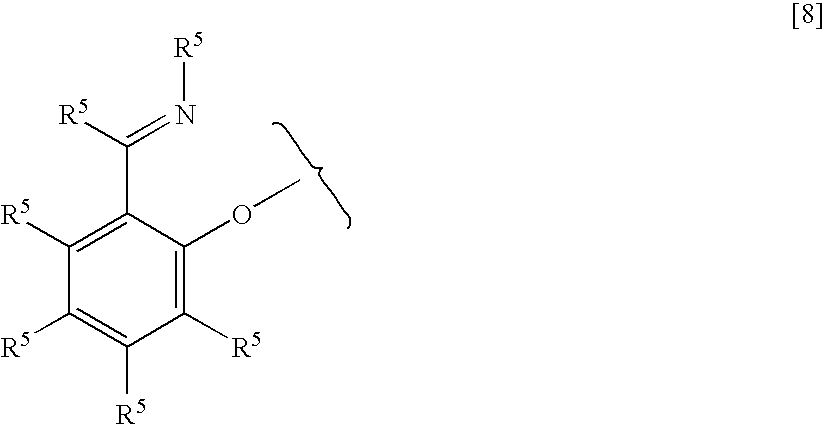Process for producing compound, catalyst component for addition polymerization, process for producing catalyst for addition polymerization, and process for producing addition polymer
a technology of addition polymerization and catalyst, which is applied in the direction of catalyst activation/preparation, group 3/13 element organic compounds, and iron organic compounds, etc., can solve the problem that the molecular weight of addition polymer produced using a large amount of hydrogen as a molecular weight regulator is small, and achieves efficient addition polymerization and high performance
- Summary
- Abstract
- Description
- Claims
- Application Information
AI Technical Summary
Benefits of technology
Problems solved by technology
Method used
Image
Examples
example 1
(1) Production of Compound
[0139]Into a 200 ml four-necked flask purged with nitrogen, 90.0 ml of toluene and 10.0 ml (20.0 mmol of trimethylaluminum) of a toluene solution (concentration=2.00 mol / liter) of trimethylaluminum were put, and the resultant mixture was cooled to 5° C. To the cooled mixture, 2.8 ml (26.6 mmol) of 1,1,1,3,3,3-hexafluoro-2-propanol was added dropwise over 1.5 hours, and then, the mixture was stirred for 1.5 hours at 5° C. Thereafter, the mixture was heated to 40° C., and was stirred for 2 hours at 40° C. The mixture was allowed to stand overnight at a room temperature, and then, was cooled to 5° C. To this mixture, 0.35 ml (19.5 mmol) of water was added dropwise over 1 hour. Thereafter, the mixture was stirred at 5° C. for 1.5 hours, at 40° C. for 2 hours, and then, at 80° C. for 2 hours, in this order, thereby obtaining a deep green slurry of a compound. From an amount of trimethylaluminum used, a concentration of an aluminum atom contained in the slurry wa...
example 2
(1) Production of Compound
[0148]Example 1 (1) was repeated except that (i) the amount of toluene was changed to 97.0 ml, and (ii) 10.0 ml (20.0 mmol of trimethylaluminum) of a toluene solution (concentration=2.00 mol / liter) of trimethylaluminum was changed to 2.7 ml (20 mmol) of triethylaluminum, thereby obtaining a slurry of a compound.
(2) Polymerization
[0149]Example 1 (2) was repeated except that (i) the slurry produced in Example 1 (1) was changed to 2.0 ml of the slurry produced in the above Example 2 (1), and (ii) the gas chromatography analysis showed a gas composition in the system of 0% by mol of hydrogen, and 6.71% by mol of 1-butene, thereby obtaining 86 g of an olefin copolymer.
[0150]A polymerization activity per mol of a zirconium atom was 2.6×108 g / mol-Zr / hour. The obtained olefin copolymer had SCB of 23.5, and MFR of 2.4 g / 10 minutes. Results are summarized in Table 1.
reference example 1
(1) Production of Compound
[0156]Example 1 (1) was repeated except that (i) the amount of toluene was changed to 97.0 ml, (ii) 10.0 ml (20.0 mmol of trimethylaluminum) of a toluene solution (concentration=2.00 mol / liter) of trimethylaluminum was changed to 2.7 ml (20 mmol) of triethylaluminum, and (iii) the step of “adding 1,1,1,3,3,3-hexafluoro-2-propanol” to the step of “cooling the mixture to 5° C.” were omitted, thereby obtaining a slurry of a compound.
(2) Polymerization
[0157]Example 1 (2) was repeated except that (i) the slurry produced in Example 1 (1) was changed to 2.0 ml of the slurry obtained in the above Reference Example 1 (1), and (ii) the gas chromatography analysis showed a gas composition in the system of 0% by mol of hydrogen, and 8.20% by mol of 1-butene, thereby obtaining 26 g of an olefin copolymer.
[0158]A polymerization activity per mol of a zirconium atom was 8.1×107 g / mol-Zr / hour. The obtained olefin copolymer had SCB of 14.8, and MFR of 5.0 g / 10 minutes. Resul...
PUM
| Property | Measurement | Unit |
|---|---|---|
| polymerization time | aaaaa | aaaaa |
| temperature | aaaaa | aaaaa |
| temperature | aaaaa | aaaaa |
Abstract
Description
Claims
Application Information
 Login to View More
Login to View More - R&D
- Intellectual Property
- Life Sciences
- Materials
- Tech Scout
- Unparalleled Data Quality
- Higher Quality Content
- 60% Fewer Hallucinations
Browse by: Latest US Patents, China's latest patents, Technical Efficacy Thesaurus, Application Domain, Technology Topic, Popular Technical Reports.
© 2025 PatSnap. All rights reserved.Legal|Privacy policy|Modern Slavery Act Transparency Statement|Sitemap|About US| Contact US: help@patsnap.com


